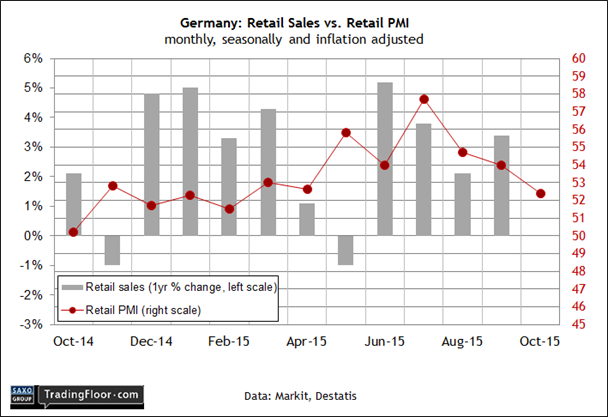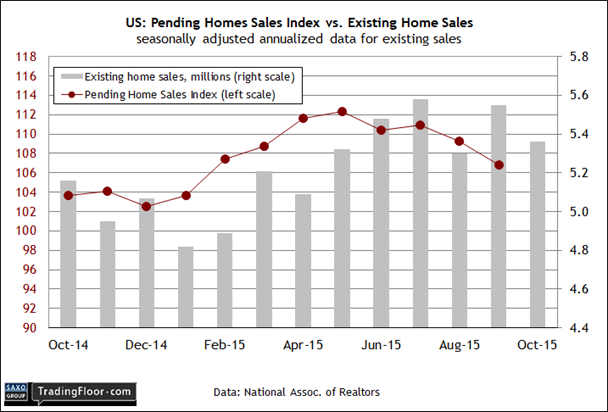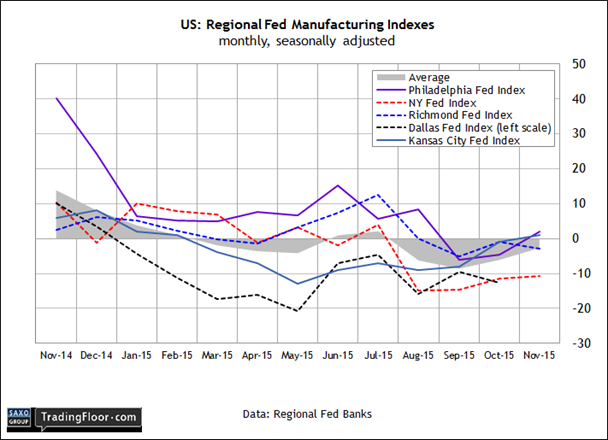Monday’s a busy news day for macro, including the hard numbers on October's retail sales for Germany. Later, two US releases will shed light on residential real estate (pending home sales data for October) and manufacturing (regional manufacturing activity in the Dallas Fed region).
Germany: Retail Sales (0700 GMT): Consumer sentiment ticked lower in Europe’s largest economy in last week’s update from Gfk. The group’s Consumer Climate Index slipped for the fourth straight month, dipping to the lowest level since February.
Weighing on the mood, according to Gfk, is concern about the labour market. Sixty-nine per cent of respondents expected the unemployment figures to worsen in the coming months. “The economic mood among German citizens currently paints a much more pessimistic view than the impression created by the actual prevailing conditions and expert assessments,” noted Gfk. “In its recently published Annual Economic Report 2015/16, the German Council of Economic Experts estimated that Germany's gross domestic product will grow by 1.7% in 2015 and 1.6% in 2016.”
A softer trend was also reflected in Markit’s purchasing managers’ index for the retail sector in October. The headline data fell last month to 52.4, the lowest since February. “Unspectacular growth,” as Markit labeled last month’s PMI reading.
It’ll be useful to see how today’s hard numbers on retail spending for October compare. The-year-over-year trend has been trending lower lately, but only moderately. Considering the weaker sentiment readings we’ve seen this month, it wouldn’t be surprising if the annual pace of spending in October dips from the previous month’s 3.4% gain.
A modest retreat into the mid-2% range wouldn’t be particularly troubling at this point. But if the year-over-year trend falls below August’s 2.1% pace, the market will have a new reason to question recent forecasts that consumption will remain a key source of support for Germany’s economy in the months ahead.

US: Pending Home Sales Index (1500 GMT): Last week’s news of a sharp rebound in sales of newly built single-family houses in October eased worries that the housing sector is stumbling. The Commerce Department reported that purchases jumped 10.7% last month vs. September – the most in more than a year.
The robust increase represents a solid rebound after September’s hefty 12.9% loss. Nonetheless, the year-over-year trend remains low by recent standards and so it’s unclear if the latest bounce is a one-off event.
Today’s update of the Pending Home Sales Index for October will offer deeper perspective for deciding if the appetite for house buying is losing strength or stabilising. Considered a leading indicator for existing sales – the dominant slice of transactions – today’s figures will be widely read after the deeper-than-expected fall in sales of existing houses.
“The mixed signals of slowing economic growth and volatility in the financial markets slightly tempered demand and contributed to the decreasing pace of [existing] sales,” the chief economist at the National Association of Realtors (NAR) said last week.
Nonetheless, NAR's Lawrence Yun remains upbeat, arguing that the future for the housing sector is still bright. “As long as solid job creation continues, a gradual easing of credit standards even with moderately higher mortgage rates should support steady demand and sales continuing to rise above a year ago.”
A BMO Capital Markets economist offered a similar outlook: “Despite the setback, home sales should resume higher in the face of rising rents, good job growth, improved consumer confidence and still-low mortgage rates.”
Today’s report will help the crowd decide if a sunny view for home purchases is still a reasonable assumption. Briefing.com’s consensus forecast advises us to keep hope alive. A modest rebound of 0.7% for the pending sales data is expected following September’s 2.3% tumble. That still leaves the index close to its lowest level so far this year, but an increase will at least temper the worst fears until the next round of housing releases.

US: Dallas Fed Manufacturing Index (1530 GMT): New orders for durable goods rebounded in October, rising 3.0% vs. the previous month – double the expected rise. Is that a sign that the ailing manufacturing sector is on the mend?
Perhaps, although a big source of the increase was due to the volatile aircraft sector. Stripping out these numbers shows that orders rose a modest 0.5%. That’s still an improvement over the hefty slide in the previous months, but it still looks like manufacturing will remain sluggish at best.
Sluggish growth would nevertheless be an improvement. Previously released November data for several regional Fed banks hint at the possibility that this battered sector may be stabilising after a rough year. Four of the five benchmarks for this month have been published and the average headline reading has inched higher for the second month in a row. Granted, flat to moderately negative readings still prevail but it’s starting to look as if the worst has passed.
The question is how today’s numbers from the Dallas Fed compare. Manufacturing in this region of the US has been hit hard, in large part because of the bear market in energy, which has an above-average influence in the Dallas Fed region. Economists see the big squeeze easing a bit, but only slightly.
Econoday.com’s consensus forecast calls for the headline index to inch higher to negative 11. That’s a small step in the right direction, but the slide in energy prices is still taking a heavy toll on manufacturing in the oil patch.

Disclosure: Originally published at Saxo Bank TradingFloor.com
